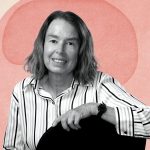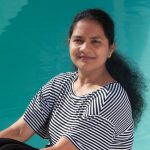INSIGHTS Pamela Maher Seeking treatments for Alzheimer's disease
Pamela Maher has always enjoyed working at the bench. Decades into a scientific career that has spanned two countries and five institutions, she makes sure to find time to run her own experiments amid the many demands of running a research lab.
Maher leads the Cellular Neurobiology Laboratory, taking charge of the group after her late husband, longtime Salk Professor David Schubert, passed away last summer. Schubert arrived at Salk in 1965 as a graduate student and five years later established the Institute’s first neurobiology lab. In 2004, Maher joined Schubert’s lab as a senior staff scientist after professorships at nearby institutions. Since then, Maher has made important contributions towards understanding and finding a treatment for Alzheimer’s disease—a long-standing goal that continues to motivate her. “Being able to treat or at least delay the onset of Alzheimer’s could have a huge impact on people’s lives—not only for the lives of patients but also their families,” she says.
DAY-TO-DAY
When Maher isn’t at her bench, she’s making sure the lab runs smoothly. She spends much of her time helping members of the lab over weekly group meetings and one-on-one talks via videoconference on Zoom in addition to managing grants, publications and administrative duties.
PATH TO SALK
Maher grew up in Connecticut and was drawn further north to study biochemistry at McGill University in Montreal as an undergraduate. She stayed in Canada for her PhD, also in biochemistry, at the University of British Columbia, where she studied the molecules that regulate the cellular membrane. This interest in cell membranes brought her to UC San Diego, to work as a postdoctoral researcher with cell biologist Jon Singer, extending the lab’s groundbreaking work on the regulation of cell membrane structure and function.
During her time at UC San Diego, she grew to love the area and decided to look for research opportunities in San Diego. She found an opportunity as an assistant professor at the Whittier Institute for Diabetes and Endocrinology in La Jolla, where she worked for five years until the institute closed. She then moved to the Scripps Research Institute as an associate professor. Then, in 2004, when the department was changing directions, her husband, Dave, suggested, “Why don’t you come to Salk and work with me?”
Maher accepted his offer, citing the appeal of being able to spend more time at the bench and the fact that her research topics and Schubert’s had begun to converge.
RESEARCH AT SALK
Since joining Salk, Maher’s major focus has been on Alzheimer’s disease. Together with Schubert, Maher has worked on identifying pathways involved in the loss of nerve cells and finding compounds that can target those pathways. More recently, Maher has also studied how these pathways affect aging. “Since aging is a major risk factor in Alzheimer’s disease, if you can slow down processes that are involved in aging, you should be able to slow down or stop the development of Alzheimer’s,” she says.
One compound based on the natural product curcumin that was discovered in the lab and the focus of much of Schubert’s recent work is now in phase 1 clinical trials for the treatment of Alzheimer’s. Maher helped develop another compound based on a natural product found in strawberries that just received investigational new drug approval from the FDA, which means the researchers are allowed to start clinical trials on the compound.
Yet, identifying a compound that becomes an actual drug is still a challenge. Maher says despite the field’s many “shots on goal,” so to speak, no new drugs have been approved to treat Alzheimer’s since 2003. So, although the compounds the lab has developed so far are promising, Maher says she’ll continue to search for additional compounds with therapeutic value.
LEISURE TIME
Maher has a large garden in her backyard, which includes a variety of plants including cycads, succulents, palm trees and orchids. She enjoys not only the garden’s spectacular views but also the satisfaction of knowing that it’s the result of the time that she and Schubert spent creating it and that she continues to devote to it.
INSPIRATION
Plants are also a great source of inspiration for Maher because of their potential to possess compounds that could treat diseases. She points out that plants have been used in medicine for thousands of years and offer a bountiful starting point for scientists. “I think there’s a lot of possibilities still out there that haven’t been explored,” she says.
FUN FACT
Maher and Schubert got to know each another in the mid-1980s while training for triathlons. Neither were very good swimmers and they ended up taking the same swim class at UCSD. “We met in the slow lane,” Maher says with a laugh. They married in 1988.
LONG VIEW
People don’t realize the extent to which Alzheimer’s disease is heterogenous, Maher says. She likens it to the early days of cancer research, when scientists believed there might be a “magic bullet” to treat all cancers. Many patients with Alzheimer’s have different pathologies in their brain, which suggests that a single drug may not be able to treat all patients. She says that this heterogeneity is yet another motivator to discover as many compounds as possible with the potential to treat Alzheimer’s disease.
Support a legacy where cures begin.
Featured Stories
 The aging puzzle comes togetherAging is a complex puzzle, but by applying a collaborative, multidisciplinary approach, Salk scientists are putting its many pieces together.
The aging puzzle comes togetherAging is a complex puzzle, but by applying a collaborative, multidisciplinary approach, Salk scientists are putting its many pieces together. Dmitry Lyumkis – A passion for problem solvingAssistant Professor Dmitry Lyumkis discusses what he loves about data and the scientific process, and which places inspire him outside the lab.
Dmitry Lyumkis – A passion for problem solvingAssistant Professor Dmitry Lyumkis discusses what he loves about data and the scientific process, and which places inspire him outside the lab.
 Pamela Maher – Seeking treatments for Alzheimer’s diseaseFrom having a large garden to investigating compounds that plants make, Staff Scientist Pam Maher talks about how plants inspire her to find treatments for Alzheimer’s disease.
Pamela Maher – Seeking treatments for Alzheimer’s diseaseFrom having a large garden to investigating compounds that plants make, Staff Scientist Pam Maher talks about how plants inspire her to find treatments for Alzheimer’s disease. Rajasree Kalagiri – Bound to phosphohistidineRajasree Kalagiri shares the serendipitous steps along her journey of scientific discovery from southern India to Southern California.
Rajasree Kalagiri – Bound to phosphohistidineRajasree Kalagiri shares the serendipitous steps along her journey of scientific discovery from southern India to Southern California.




















































